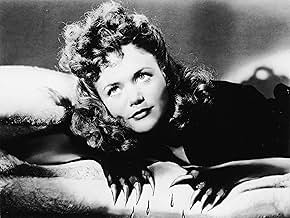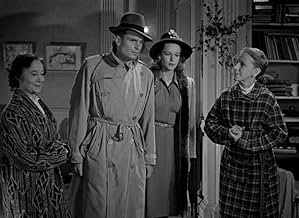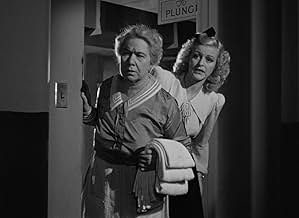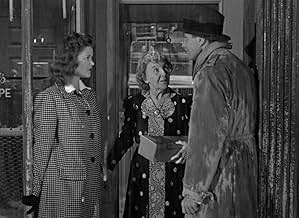NOTE IMDb
7,2/10
28 k
MA NOTE
Un Américain épouse une immigrée serbe qui a peur de se transformer en féline, comme dans les fables de son pays natal, s'ils deviennent intimes.Un Américain épouse une immigrée serbe qui a peur de se transformer en féline, comme dans les fables de son pays natal, s'ils deviennent intimes.Un Américain épouse une immigrée serbe qui a peur de se transformer en féline, comme dans les fables de son pays natal, s'ils deviennent intimes.
- Récompenses
- 2 victoires et 3 nominations au total
Henrietta Burnside
- Sue Ellen
- (non crédité)
Alec Craig
- Zookeeper
- (non crédité)
Eddie Dew
- Street Policeman
- (non crédité)
Elizabeth Dunne
- Mrs. Plunkett
- (non crédité)
Dynamite
- The Panther
- (non crédité)
Dot Farley
- Mrs. Agnew
- (non crédité)
Mary Halsey
- Blondie
- (non crédité)
Theresa Harris
- Minnie
- (non crédité)
Charles Jordan
- Bus Driver
- (non crédité)
Donald Kerr
- Taxi Driver
- (non crédité)
Connie Leon
- Neighbor Who Called Police
- (non crédité)
Murdock MacQuarrie
- Sheep Caretaker
- (non crédité)
Alan Napier
- Doc Carver
- (non crédité)
Avis à la une
Cat People is one of the horror genre's most influential films, it's one of the first psychological horrors or at least one of the first to play on the fears of the audience. But Cat People is more than just an influential film, it's also a great one and holds up terrifically well.
It's very well made, with beautiful cinematography and great and effective use of shadows and shadowy lighting. The sets are also hauntingly sumptuous. Cat People has a haunting music score and a very intelligent script that has a good amount of tension as well as a bit of subtle wit. The story, and the atmosphere it has, is one of the main reasons why Cat People works so well, this is more than a monster/ghost feature, this is more a psychological horror that relies on suspense and playing on the audience's fear. Both of which Cat People does splendidly, the suspense in the best parts is positively nerve-shredding and the whole film has a constant eeriness that makes it creepy without resulting to cheap shocks, jump scares or gore. For me the two most effective scenes have always been with the pool and the walk through the park, the latter being justifiably famous and contains a very clever "false shock". It's beautifully directed by Jacques Tourneur, the characters are interesting and the acting is mostly solid if not the best, with Simone Simon being superb. Simon brings a sensuality, menace and poignancy to her role, that makes her presence chillingly mysterious but at times moving. Tom Conway does just fine too.
If there is anything to criticise, Kent Smith is very stiff here. Other than that Cat People is great, both of its genre and as a film in general. 9/10 Bethany Cox
It's very well made, with beautiful cinematography and great and effective use of shadows and shadowy lighting. The sets are also hauntingly sumptuous. Cat People has a haunting music score and a very intelligent script that has a good amount of tension as well as a bit of subtle wit. The story, and the atmosphere it has, is one of the main reasons why Cat People works so well, this is more than a monster/ghost feature, this is more a psychological horror that relies on suspense and playing on the audience's fear. Both of which Cat People does splendidly, the suspense in the best parts is positively nerve-shredding and the whole film has a constant eeriness that makes it creepy without resulting to cheap shocks, jump scares or gore. For me the two most effective scenes have always been with the pool and the walk through the park, the latter being justifiably famous and contains a very clever "false shock". It's beautifully directed by Jacques Tourneur, the characters are interesting and the acting is mostly solid if not the best, with Simone Simon being superb. Simon brings a sensuality, menace and poignancy to her role, that makes her presence chillingly mysterious but at times moving. Tom Conway does just fine too.
If there is anything to criticise, Kent Smith is very stiff here. Other than that Cat People is great, both of its genre and as a film in general. 9/10 Bethany Cox
Jacques Tourneur directed this Val Lewton production that stars Simone Simon as Irina Dubrovna, a Serbian immigrant working as a fashion artist in New York City who meets Oliver Reed(played by Kent Smith) at the zoo. They fall in love and get married, but run into trouble when she finds herself afraid of intimacy, since she believes the fables and legends of her homeland that indicate she is descended from a cursed line of Cat People, who turn murderous when aroused. He scoffs at this, but when his friend & co-worker Alice(played by Jane Randolph) is stalked by a cat-like creature, he begins to wonder. Meanwhile, Irina sees psychiatrist Dr. Louis Judd(played by Tom Conway) who has designs on Irina himself... Eerie and original film avoids monster movie clichés to create an effective atmosphere of dread. Quite intelligent as well, though requires patience, since it is decidedly different!
This movie provides a good demonstration of how you can still generate good suspense without violence seen on-screen. Director Jacques Tourneur and producer Val Lewton liked these kind of film presentations. This was Lewton's first film, by the way. Viewers either seem to really be for this slower classic style, or totally turned off by these kind of films. It depends, I suppose, on what you are expecting and what kind of movies you like. If you are looking for an action-packed film, with some bloody or horrible scenes, skip this film. It will just bore you to death.
If you prefer the implied violent acts, horror, and even sexual stuff , then this is your cup of tea. It's very "moody."
Simon Simone does well in the key role of "Irena Dubrovna." Animals fear her and she fears getting attached to someone, such as "Oliver Reed" (Kent Smith) who comes along and there is mutual attraction. What happens to those two, and others I won't say. The film is only 72 minutes so why divulge what's in it? Just know what to expect. This is a far cry from today's horror films.
If you prefer the implied violent acts, horror, and even sexual stuff , then this is your cup of tea. It's very "moody."
Simon Simone does well in the key role of "Irena Dubrovna." Animals fear her and she fears getting attached to someone, such as "Oliver Reed" (Kent Smith) who comes along and there is mutual attraction. What happens to those two, and others I won't say. The film is only 72 minutes so why divulge what's in it? Just know what to expect. This is a far cry from today's horror films.
'Cat People' was the first collaboration between director Jacques Tourneur ('Curse Of The Demon') and producer Val Lewton, and is still one of their greatest achievements, and one of the most influential horror movies ever made. It's arguably the best horror movie made between the Universal classics of the 1930s and the beginning of Hammer studios in the 1950s. So many subsequent film makers from Hitchcock on down have been influenced by this movie and yet it rarely gets the respect it deserves. 'Cat People' pretends to be a monster movie but is really something more complex, and relies on atmosphere and suspense rather than explicit shocks or gore (there is virtually none of the latter). Fans of Hitchcock and film noir will probably appreciate it more than hardcore gorehounds. Simone Simon is very well cast as the mysterious and troubled Irena and the rest of the cast range from adequate to very good. The acting is probably one of the weakest links in the film but not enough to spoil your enjoyment (I think 1940s acting is an acquired taste and I can see how a modern viewer who expects more realistic and natural performances could sometimes find them a bit hard to swallow). 'Cat People' is a horror classic and is highly recommended to anyone interested in the genre.
I have this theory about the horror films of Val Lewton. It is my contention that these movies caused a sea change in the content and tone of the movies of Alfred Hitchcock. The reason I say this is simple, really: Lewton is the only filmmaker I have ever caught Hitchcock cribbing scenes from. He did it twice. Once from The Seventh Victim (dir. by Mark Robson), which I swear to god provides the first half of the Shower Scene from Psycho. The second from Cat People, which provided the pet store scene in The Birds. This second scene is almost a shot for shot swipe. Both of these steals are evidence that Hitch knew and admired the Lewton movies. More than that, though, there is a change in the subtext of Hitchcock's thrillers after the Lewton movies. The movies he made before them were cut from the Fritz Lang mold of political thrillers. After the Lewton movies, Hitch's movies became more psychosexual in nature. Vertigo, for instance, could easily fit into Lewton's output.
Cat People is the first of the Lewton movies and sets the tone for them. It pretends to be about a McGuffin (serbian were -panthers), but is actually about something else (in this case, frigidity and repressed lesbianism). This represents a huge change in the evolution of the horror movie. Cat People is the first horror movie to explore these themes as central concerns rather than as sub-rosa undercurrents. It also pioneered the techniques of film noir (which as a genre didn't really exist yet). Cat People is strikingly stylized and its effect is of stranding the viewer in the middle of a darkened room with some dreadful beast circling just outside his sphere of perception. This has a hell of an impact--particularly if you have the good fortune to see this in a theater. I'm not going to claim that Cat People is one of the best horror movies ever made (it does have flaws), but it is one of the four most influential horror movies ever made (along with The Cabinet of Dr. Caligari, Psycho, and Night of the Living Dead). But unlike its brethren, its influence spreads corrosively through the entirety of cinema through both film noir and the films of Alfred Hitchcock. You would be hard pressed to find any film short of Citizen Kane or Rashomon that is nearly as influential.
Cat People is the first of the Lewton movies and sets the tone for them. It pretends to be about a McGuffin (serbian were -panthers), but is actually about something else (in this case, frigidity and repressed lesbianism). This represents a huge change in the evolution of the horror movie. Cat People is the first horror movie to explore these themes as central concerns rather than as sub-rosa undercurrents. It also pioneered the techniques of film noir (which as a genre didn't really exist yet). Cat People is strikingly stylized and its effect is of stranding the viewer in the middle of a darkened room with some dreadful beast circling just outside his sphere of perception. This has a hell of an impact--particularly if you have the good fortune to see this in a theater. I'm not going to claim that Cat People is one of the best horror movies ever made (it does have flaws), but it is one of the four most influential horror movies ever made (along with The Cabinet of Dr. Caligari, Psycho, and Night of the Living Dead). But unlike its brethren, its influence spreads corrosively through the entirety of cinema through both film noir and the films of Alfred Hitchcock. You would be hard pressed to find any film short of Citizen Kane or Rashomon that is nearly as influential.
Le saviez-vous
- AnecdotesThe horror movie technique of slowly building tension to a jarring shock which turns out to be something completely harmless and benign became known as a "Lewton bus" after a famous scene in this movie created by producer Val Lewton. The technique is also referred to as a "cat scare," as off-screen noises are often revealed to be a startled harmless cat.
- GaffesWhen Irena does not show up at her apartment when Dr. Judd, Oliver, and Alice are waiting for her, they leave. Dr. Judd hides his cane in the apartment to give him an excuse to borrow Oliver's key and go back in for it. Afterward, he leaves the door unlocked so that he can sneak back in, something that is hidden from Oliver and Alice. Yet, after Oliver and Alice are threatened in the office, they call the apartment to warn Dr. Judd that Irena is definitely dangerous and that he should leave.
- Citations
Irena Dubrovna: I like the dark. It's friendly.
- Crédits fous[From the opening credits] "Even as fog continues to lie in the valleys, so does ancient sin cling to the low places, the depression sin the world consciousness." - "The Anatomy of Atavism" - Dr. Louis Judd
- ConnexionsFeatured in Draculeena Presents: Cat People (1960)
Meilleurs choix
Connectez-vous pour évaluer et suivre la liste de favoris afin de recevoir des recommandations personnalisées
Détails
- Date de sortie
- Pays d’origine
- Langues
- Aussi connu sous le nom de
- La marca de la pantera
- Lieux de tournage
- Société de production
- Voir plus de crédits d'entreprise sur IMDbPro
Box-office
- Budget
- 134 000 $US (estimé)
- Durée
- 1h 13min(73 min)
- Couleur
- Rapport de forme
- 1.37 : 1
Contribuer à cette page
Suggérer une modification ou ajouter du contenu manquant






































